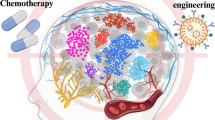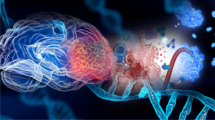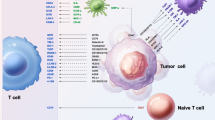Abstract
Glioblastoma, a grade IV astrocytoma, is considered as the most malignant intracranial tumor, characterized by poor prognosis and therapy resistance. Tumor heterogeneity that often leads to distinct functional phenotypes contributes to glioblastoma (GB) indispensable growth and aggressiveness. The complex interaction of neoplastic cells with tumor microenvironment (TME) along with the presence of cancer stem-like cells (CSCs) largely confers to extrinsic and intrinsic GB heterogeneity. Recent data indicate that glioma cells secrete a variety of soluble immunoregulatory factors to attract different cell types to TME including astrocytes, endothelial cells, circulating stem cells, and a range of immune cells. These further induce a local production of cytokines, chemokines, and growth factors which upon crosstalk with extracellular matrix (ECM) components reprogram immune cells to inflammatory or anti-inflammatory phenotypes and manipulate host’s immune response in favor of cancer growth and metastasis. Herein, we provide an overview of the immunobiologic factors that orchestrate the complex network of glioma cells and TME interactions in an effort to identify potential therapeutic targets for GB malignancy. Current therapeutic schemes and advances in targeting GB-TME crosstalk are further discussed.
Key messages
• Intrinsic and extrinsic tumor heterogeneity affects GB growth and aggressiveness.
• GB cells secrete growth factors and chemoattractants to recruit immune cells to TME.
• GAMs are a critical cell type in promoting GB growth.
• GAMs change from pro-inflammatory, anti-tumor M1 phenotype to pro-tumorigenic M2.
• Novel therapeutic agents target the crosstalk of neoplastic cells with TME.

Similar content being viewed by others
References
Zisakis A, Piperi C, Themistocleous MS, Korkolopoulou P, Boviatsis EI, Sakas DE, Patsouris E, Lea RW, Kalofoutis A (2007) Comparative analysis of peripheral and localised cytokine secretion in glioblastoma patients. Cytokine 39:99–105
Louis DN, Perry A, Reifenberger G, von Deimling A, Figarella-Branger D, Cavenee WK, Ohgaki H, Wiestler OD, Kleihues P, Ellison DW (2016) The 2016 World Health Organization classification of tumors of the central nervous system: a summary. Acta Neuropathol 131:803–820
Ohgaki H, Kleihues P (2013) The definition of primary and secondary glioblastoma. Clin Cancer Res 19:764–772
Kleinschmidt-DeMasters BK, Aisner DL, Foreman NK (2015) BRAF VE1 immunoreactivity patterns in epithelioid glioblastomas positive for BRAF V600E mutation. Am J Surg Pathol 39:528–540
Meyer M, Reimand J, Lan X, Head R, Zhu X, Kushida M, Bayani J, Pressey JC, Lionel AC, Clarke ID, Cusimano M, Squire JA, Scherer SW, Bernstein M, Woodin MA, Bader GD, Dirks PB (2015) Single cell-derived clonal analysis of human glioblastoma links functional and genomic heterogeneity. Proc Natl Acad Sci U S A 112:851–856
Darmanis S, Sloan SA, Croote D, Mignardi M, Chernikova S, Samghababi P, Zhang Y, Neff N, Kowarsky M, Caneda C, Li G, Chang SD, Connolly ID, Li Y, Barres BA, Gephart MH, Quake SR (2017) Single-cell RNA-Seq analysis of infiltrating neoplastic cells at the migrating front of human glioblastoma. Cell Rep 21:1399–1410
Nikitin PV, Ryzhova MV, Zubova IV, Panina TN, Shugay SV (2019) Heterogeneity of tumor cells in glioblastomas. Arkh Patol 81:27–36
Gieryng A, Pszczolkowska D, Walentynowicz KA, Rajan WD, Kaminska B (2017) Immune microenvironment of gliomas. Lab Investig 97:498–518
Matias D, Balça-Silva J, da Graça GC, Wanjiru CM, Macharia LW, Nascimento CP, Roque NR, Coelho-Aguiar JM, Pereira CM, Dos Santos MF, Pessoa LS, Lima FRS, Schanaider A, Ferrer VP, Tania Cristina Leite de Sampaio e Spohr, Moura-Neto V (2018) Microglia/astrocytes–glioblastoma crosstalk: crucial molecular mechanisms and microenvironmental factors. Front Cell Neurosci 12:235
Goods BA, Hernandez AL, Lowther DE, Lucca LE, Lerner BA, Gunel M, Raddassi K, Coric V, Hafler DA, Love JC (2017) Functional differences between PD-1+ and PD-1- CD4+ effector T cells in healthy donors and patients with glioblastoma multiforme. PLoS One 12:e0181538
Wherry EJ, Kurachi M (2015) Molecular and cellular insights into T cell exhaustion. Nat Rev Immunol 15:486–499
Chang C-H, Qiu J, O’Sullivan D, Buck MD, Noguchi T, Curtis JD, Chen Q, Gindin M, Gubin MM, van der Windt GJW, Tonc E, Schreiber RD, Pearce EJ, Pearce EL (2015) Metabolic competition in the tumor microenvironment is a driver of cancer progression. Cell 162:1229–1241
Humphries W, Wei J, Sampson JH, Heimberger AB (2010) The role of tregs in glioma-mediated immunosuppression: potential target for intervention. Neurosurg Clin N Am 21:125–137
Hussain SF, Yang D, Suki D et al (2006) The role of human glioma-infiltrating microglia/macrophages in mediating antitumor immune responses. Neuro Oncol 8:261–279
Heimberger AB, Abou-Ghazal M, Reina-Ortiz C, Yang DS, Sun W, Qiao W, Hiraoka N, Fuller GN (2008) Incidence and prognostic impact of FoxP3+ regulatory T cells in human gliomas. Clin Cancer Res 14:5166–5172
Pyonteck SM, Akkari L, Schuhmacher AJ, Bowman RL, Sevenich L, Quail DF, Olson OC, Quick ML, Huse JT, Teijeiro V, Setty M, Leslie CS, Oei Y, Pedraza A, Zhang J, Brennan CW, Sutton JC, Holland EC, Daniel D, Joyce JA (2013) CSF-1R inhibition alters macrophage polarization and blocks glioma progression. Nat Med 19:1264–1272
Roesch S, Rapp C, Dettling S, Herold-Mende C (2018) When immune cells turn bad-tumor-associated microglia/macrophages in glioma. Int J Mol Sci 19. https://doi.org/10.3390/ijms19020436
Aspord C, Pedroza-Gonzalez A, Gallegos M, Tindle S, Burton EC, Su D, Marches F, Banchereau J, Palucka AK (2007) Breast cancer instructs dendritic cells to prime interleukin 13-secreting CD4+ T cells that facilitate tumor development. J Exp Med 204:1037–1047
Yu X, Harden K, C Gonzalez L, Francesco M, Chiang E, Irving B, Tom I, Ivelja S, Refino CJ, Clark H, Eaton D, Grogan JL (2009) The surface protein TIGIT suppresses T cell activation by promoting the generation of mature immunoregulatory dendritic cells. Nat Immunol 10:48–57
Dhodapkar MV, Steinman RM, Krasovsky J, Munz C, Bhardwaj N (2001) Antigen-specific inhibition of effector T cell function in humans after injection of immature dendritic cells. J Exp Med 193:233–238
Marvel D, Gabrilovich DI (2015) Myeloid-derived suppressor cells in the tumor microenvironment: expect the unexpected. J Clin Invest 125:3356–3364
Raychaudhuri B, Rayman P, Ireland J, Ko J, Rini B, Borden EC, Garcia J, Vogelbaum MA, Finke J (2011) Myeloid-derived suppressor cell accumulation and function in patients with newly diagnosed glioblastoma. Neuro-Oncology 13:591–599
Poli A, Wang J, Domingues O, Planagumà J, Yan T, Skaftnesmo KO, Rygh CB, Thorsen F, McCormack E, Hentges F, Pedersen PH, Zimmer J, Enger PØ, Chekenya M (2013) Targeting glioblastoma with NK cells and mAb against NG2/CSPG4 prolongs animal survival. Oncotarget 4:1527–1546
Crane CA, Han SJ, Barry JJ, Ahn BJ, Lanier LL, Parsa AT (2010) TGF-beta downregulates the activating receptor NKG2D on NK cells and CD8+ T cells in glioma patients. Neuro-Oncology 12:7–13
Kunkel P, Müller S, Schirmacher P et al (2001) Expression and localization of scatter factor/hepatocyte growth factor in human astrocytomas. Neuro-Oncology 3:82–88
Hinojosa AE, Garcia-Bueno B, Leza JC, Madrigal JLM (2011) CCL2/MCP-1 modulation of microglial activation and proliferation. J Neuroinflammation 8:77
Rot A, von Andrian UH (2004) Chemokines in innate and adaptive host defense : basic chemokinese grammar for immune cells. Annu Rev Immunol 22:891–928
Menten P, Wuyts A, Van Damme J (2002) European cytokine network. John Libbey Eurotext Ltd
Wiesenhofer B, Stockhammer G, Kostron H, Maier H, Hinterhuber H, Humpel C (2000) Glial cell line-derived neurotrophic factor (GDNF) and its receptor (GFR-alpha 1) are strongly expressed in human gliomas. Acta Neuropathol 99:131–137
Ku M-C, Wolf SA, Respondek D, Matyash V, Pohlmann A, Waiczies S, Waiczies H, Niendorf T, Synowitz M, Glass R, Kettenmann H (2013) GDNF mediates glioblastoma-induced microglia attraction but not astrogliosis. Acta Neuropathol 125:609–620
Kjellman C, Olofsson SP, Hansson O, von Schantz T, Lindvall M, Nilsson I, Salford LG, Sjögren HO, Widegren B (2000) Expression of TGF-β isoforms, TGF-β receptors, and SMAD molecules at different stages of human glioma. Int J Cancer 89:251–258
Taniguchi Y, Ono K, Yoshida S, Tanaka R (2000) Antigen-presenting capability of glial cells under glioma-harboring conditions and the effect of glioma-derived factors on antigen presentation. J Neuroimmunol 111:177–185
Li W, Graeber MB (2012) The molecular profile of microglia under the influence of glioma. Neuro-Oncology 14:958–978
Zhou W, Ke SQ, Huang Z, Flavahan W, Fang X, Paul J, Wu L, Sloan AE, McLendon RE, Li X, Rich JN, Bao S (2015) Periostin secreted by glioblastoma stem cells recruits M2 tumour-associated macrophages and promotes malignant growth. Nat Cell Biol 17:170–182
Raychaudhuri B, Vogelbaum MA (2011) IL-8 is a mediator of NF-κB induced invasion by gliomas. J Neuro-Oncol 101:227–235
Liang Q, Ma C, Zhao Y, Gao G, Ma J (2013) Inhibition of STAT3 reduces astrocytoma cell invasion and constitutive activation of STAT3 predicts poor prognosis in human astrocytoma. PLoS One 8:e84723
Kahlert UD, Nikkhah G, Maciaczyk J (2013) Epithelial-to-mesenchymal(-like) transition as a relevant molecular event in malignant gliomas. Cancer Lett 331:131–138
Zhang B, Shi L, Lu S, Sun X, Liu Y, Li H, Wang X, Zhao C, Zhang H, Wang Y (2015) Autocrine IL-8 promotes F-actin polymerization and mediate mesenchymal transition via ELMO1-NF-κB-snail signaling in glioma. Cancer Biol Ther 16:898–911
Gately S, Li WW (2004) Multiple roles of COX-2 in tumor angiogenesis: a target for antiangiogenic therapy. Semin Oncol 31:2–11
Turkowski K, Brandenburg S, Mueller A, Kremenetskaia I, Bungert AD, Blank A, Felsenstein M, Vajkoczy P (2018) VEGF as a modulator of the innate immune response in glioblastoma. Glia 66:161–174
Zhu W, Carney KE, Pigott VM, Falgoust LM, Clark PA, Kuo JS, Sun D (2016) Glioma-mediated microglial activation promotes glioma proliferation and migration: roles of Na+/H+ exchanger isoform 1. Carcinogenesis 37:839–851
MartIn-Fontecha A, Sebastiani S, Höpken UE et al (2003) Regulation of dendritic cell migration to the draining lymph node: impact on T lymphocyte traffic and priming. J Exp Med 198:615–621
Nickl-Jockschat T, Arslan F, Doerfelt A, Bogdahn U, Bosserhoff A, Hau P (2007) An imbalance between Smad and MAPK pathways is responsible for TGF-β tumor promoting effects in high-grade gliomas. Int J Oncol 30:499–507
Chang C-Y, Li M-C, Liao S-L, Huang YL, Shen CC, Pan HC (2005) Prognostic and clinical implication of IL-6 expression in glioblastoma multiforme. J Clin Neurosci 12:930–933
Wang X, Lin Y (2008) Tumor necrosis factor and cancer, buddies or foes? Acta Pharmacol Sin 29:1275–1288
Lourenço EV, La Cava A (2009) Cytokines in systemic lupus erythematosus. Curr Mol Med 9:242–254
Costa Brandão Berti F, Brajão de Oliveira K (2018) IL-10 in cancer: just a classical immunosuppressive factor or also an immunostimulating one? AIMS Allergy Immunol 2:88–97
Moustakas A, Rosler KM, Harrison DA (2002) Smad signalling network. J Cell Sci 115:3355–3356
Iyer SS, Cheng G (2012) Role of interleukin 10 transcriptional regulation in inflammation and autoimmune disease. Crit Rev Immunol 32:23–63
Wischhusen J, Jung G, Radovanovic I et al (2002) Identification of CD70-mediated apoptosis of immune effector cells as a novel immune escape pathway of human glioblastoma. Cancer Res 62:2592–2599
Azuma T, Yao S, Zhu G, Flies AS, Flies SJ, Chen L (2008) B7-H1 is a ubiquitous antiapoptotic receptor on cancer cells. Blood 111:3635–3643
Fernandes C, Costa A, Osório L et al (2017) Current standards of care in glioblastoma therapy. Codon Publications
Grosso JF, Jure-Kunkel MN (2013) CTLA-4 blockade in tumor models: an overview of preclinical and translational research. Cancer Immun 13:5
Huang J, Liu F, Liu Z, Tang H, Wu H, Gong Q, Chen J (2017) Immune checkpoint in glioblastoma: promising and challenging. Front Pharmacol 8:242
Sadahiro H, Kang K-D, Gibson JT, Minata M, Yu H, Shi J, Chhipa R, Chen Z, Lu S, Simoni Y, Furuta T, Sabit H, Zhang S, Bastola S, Yamaguchi S, Alsheikh H, Komarova S, Wang J, Kim SH, Hambardzumyan D, Lu X, Newell EW, DasGupta B, Nakada M, Lee LJ, Nabors B, Norian LA, Nakano I (2018) Activation of the receptor tyrosine kinase AXL regulates the immune microenvironment in glioblastoma. Cancer Res 78:3002–3013
Li J, Liu X, Duan Y, Wang H, Su W, Wang Y, Zhuang G, Fan Y (2018) Abnormal expression of circulating and tumor-infiltrating carcinoembryonic antigen-related cell adhesion molecule 1 in patients with glioma. Oncol Lett 15:3496–3503
Butowski N, Colman H, De Groot JF et al (2016) Orally administered colony stimulating factor 1 receptor inhibitor PLX3397 in recurrent glioblastoma: an Ivy Foundation early phase clinical trials consortium phase II study. Neuro-Oncology 18:557–564
Pradel LP, Ooi C-H, Romagnoli S, Cannarile MA, Sade H, Rüttinger D, Ries CH (2016) Macrophage susceptibility to Emactuzumab (RG7155) treatment. Mol Cancer Ther 15:3077–3086
Laudati E, Currò D, Navarra P, Lisi L (2017) Blockade of CCR5 receptor prevents M2 microglia phenotype in a microglia-glioma paradigm. Neurochem Int 108:100–108
Mercurio L, Ajmone-Cat MA, Cecchetti S, Ricci A, Bozzuto G, Molinari A, Manni I, Pollo B, Scala S, Carpinelli G, Minghetti L (2016) Targeting CXCR4 by a selective peptide antagonist modulates tumor microenvironment and microglia reactivity in a human glioblastoma model. J Exp Clin Cancer Res 35:55
Hira VVV, Verbovšek U, Breznik B, Srdič M, Novinec M, Kakar H, Wormer J, der Swaan BV, Lenarčič B, Juliano L, Mehta S, van Noorden CJF, Lah TT (2017) Cathepsin K cleavage of SDF-1α inhibits its chemotactic activity towards glioblastoma stem-like cells. Biochim Biophys Acta Mol Cell Res 1864:594–603
See AP, Han JE, Phallen J, Binder Z, Gallia G, Pan F, Jinasena D, Jackson C, Belcaid Z, Jeong SJ, Gottschalk C, Zeng J, Ruzevick J, Nicholas S, Kim Y, Albesiano E, Pardoll DM, Lim M (2012) The role of STAT3 activation in modulating the immune microenvironment of GBM. J Neuro-Oncol 110:359–368
Rath BH, Wahba A, Camphausen K, Tofilon PJ (2015) Coculture with astrocytes reduces the radiosensitivity of glioblastoma stem-like cells and identifies additional targets for radiosensitization. Cancer Med 4:1705–1716
Dranoff G, Jaffee E, Lazenby A, Golumbek P, Levitsky H, Brose K, Jackson V, Hamada H, Pardoll D, Mulligan RC (1993) Vaccination with irradiated tumor cells engineered to secrete murine granulocyte-macrophage colony-stimulating factor stimulates potent, specific, and long-lasting anti-tumor immunity. Proc Natl Acad Sci 90:3539–3543
Sikorski CW, Lesniak MS (2005) Immunotherapy for malignant glioma: current approaches and future directions. Neurol Res 27:703–716
Okada H, Lieberman FS, Walter KA, Lunsford LD, Kondziolka DS, Bejjani GK, Hamilton RL, Torres-Trejo A, Kalinski P, Cai Q, Mabold JL, Edington HD, Butterfield LH, Whiteside TL, Potter DM, Schold SC, Pollack IF (2007) Autologous glioma cell vaccine admixed with interleukin-4 gene transfected fibroblasts in the treatment of patients with malignant gliomas. J Transl Med 5:67
Zhu S, Lv X, Zhang X, Li T, Zang G, Yang N, Wang X, Wu J, Chen W, Liu YJ, Chen J (2019) An effective dendritic cell-based vaccine containing glioma stem-like cell lysate and CpG adjuvant for an orthotopic mouse model of glioma. Int J Cancer 144:2867–2879
Phuphanich S, Wheeler CJ, Rudnick JD, Mazer M, Wang HQ, Nuño MA, Richardson JE, Fan X, Ji J, Chu RM, Bender JG, Hawkins ES, Patil CG, Black KL, Yu JS (2013) Phase I trial of a multi-epitope-pulsed dendritic cell vaccine for patients with newly diagnosed glioblastoma. Cancer Immunol Immunother 62:125–135
Favaro R, Appolloni I, Pellegatta S, Sanga AB, Pagella P, Gambini E, Pisati F, Ottolenghi S, Foti M, Finocchiaro G, Malatesta P, Nicolis SK (2014) Sox2 is required to maintain cancer stem cells in a mouse model of high-grade oligodendroglioma. Cancer Res 74:1833–1844
Fourcade J, Sun Z, Chauvin J-M, Ka M, Davar D, Pagliano O, Wang H, Saada S, Menna C, Amin R, Sander C, Kirkwood JM, Korman AJ, Zarour HM (2018) CD226 opposes TIGIT to disrupt Tregs in melanoma. JCI Insight 3. https://doi.org/10.1172/jci.insight.121157
Lozano E, Dominguez-Villar M, Kuchroo V, Hafler DA (2012) The TIGIT/CD226 axis regulates human T cell function. J Immunol 188:3869–3875
Thaker YR, Schneider H, Rudd CE (2015) TCR and CD28 activate the transcription factor NF-κB in T-cells via distinct adaptor signaling complexes. Immunol Lett 163:113–119
Chen X, Liu Q, Xiang AP (2018) CD8+CD28- T cells: not only age-related cells but a subset of regulatory T cells. Cell Mol Immunol 15:734–736
Huff WX, Kwon JH, Henriquez M, Fetcko K, Dey M (2019) The evolving role of CD8+CD28-immunosenescent T cells in cancer immunology. Int J Mol Sci 20. https://doi.org/10.3390/ijms20112810
Lin Y, Okada H (2016) Cellular immunotherapy for malignant gliomas. Expert Opin Biol Ther 16:1265–1275
Ardon H, Van Gool S, Lopes IS et al (2010) Integration of autologous dendritic cell-based immunotherapy in the primary treatment for patients with newly diagnosed glioblastoma multiforme: a pilot study. J Neuro-Oncol 99:261–272
Prins RM, Soto H, Konkankit V, Odesa SK, Eskin A, Yong WH, Nelson SF, Liau LM (2011) Gene expression profile correlates with T-cell infiltration and relative survival in glioblastoma patients vaccinated with dendritic cell immunotherapy. Clin Cancer Res 17:1603–1615
Author information
Authors and Affiliations
Contributions
DS, MM, and AK drafted and compiled the sections of the manuscript. CP and AGP revised, edited, and approved the submitted manuscript.
Corresponding authors
Ethics declarations
Conflict of interest
The authors declare that they have no conflict of interest.
Additional information
Publisher's note
Springer Nature remains neutral with regard to jurisdictional claims in published maps and institutional affiliations.
Rights and permissions
About this article
Cite this article
Strepkos, D., Markouli, M., Klonou, A. et al. Insights in the immunobiology of glioblastoma. J Mol Med 98, 1–10 (2020). https://doi.org/10.1007/s00109-019-01835-4
Received:
Revised:
Accepted:
Published:
Issue Date:
DOI: https://doi.org/10.1007/s00109-019-01835-4




